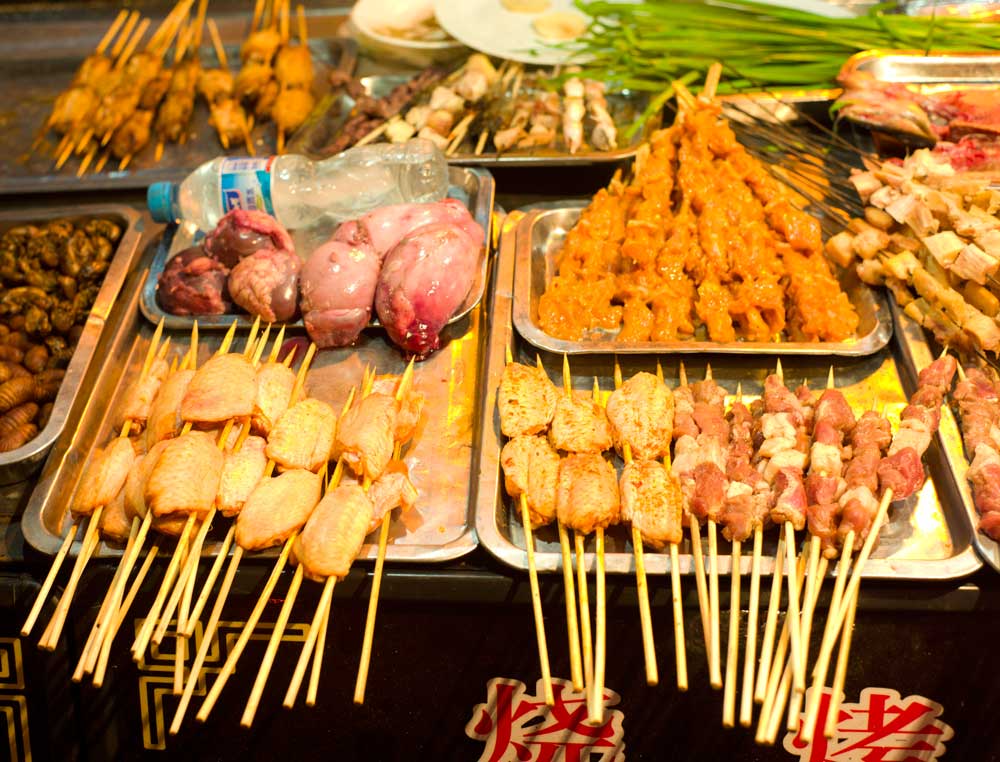By: Jamie Barys and Kyle Long, Glutton Guides
1. Inspect the vendor’s station
Cleanliness is next to godliness, especially when it comes to street food, so check out their mise en place and utensils. If your vendor has a jar for money and asks you to retrieve your own change, that’s a very good sign. Money is one of the dirtiest things we touch daily, so this means that they are already factoring that into their cleanliness.
Alternatively, some vendors use utensils or gloves when handling food, so touching money isn’t as much of an issue.
2. Check the vendor’s oil
Reused oil is a problem in a lot of the smaller cities around China, but you will occasionally run across a spendthrift vendor frying street food in dark oil. Avoid this at all costs, as reused oil can be dangerous. Most vendors do not keep their oil in its original container. Instead they pour it into smaller water bottles that are much easier to handle than a bulky jug when you’re tossing noodles in a wok with your right hand and throwing other ingredients in with your left. So, just because they are using a Coca- Cola bottle, it doesn’t mean they’re bad – just efficient. If their bottle is filled with oil that is a golden yellow color and has no debris floating in it, it’s generally good to go.
3. Time your meals around peak dining hours
When you’re not familiar with a food street, eat at peak dining times so you can make sure turnover is at its highest. This ensures whatever you’re eating is fresh. Never eat something that is pre-cooked and has been sitting out. You should select from raw ingredients and watch the vendor make it fresh before your eyes.
4. Think about what you’re eating
Different meats spoil at different rates, so it’s good to keep in mind what spoils fastest. Seafood degrades most quickly, followed by poultry. Pork, beef and lamb are the slowest to spoil. Keep in mind larger chunks of meat and fish need more time to reach a consistent temperature throughout, so smaller pieces of meat are less risky. Always make sure any meat is cooked through. A general rule of thumb to keep in mind: never eat raw seafood as street food.
5. Consider cooking techniques &temperatures
It’s also a good idea to keep in mind what cooking techniques reach the highest (and thus maximum bacteria-killing) temperatures. Poaching and simmering do not reach boiling point, whereas steaming and boiling are right at 100 ̊C / 212 ̊F. The big flame under the wok when stir-frying reaches about 150 ̊C / 300 ̊F minimum. Deep-frying is even hotter, and grilling has the highest heat.
6. Opt for brick & mortar shops
Since roving vendors can set up shop anywhere, they are not always held accountable for their food safety qualifications. Now we’re not saying avoid these at all costs – sometimes they serve the best food – but if you have the time to check they are at the same spot daily, then they’re trustworthy. Many street carts on wheels are nomadic because they hit up the same streets every day, but they choose the peak times for each corner, such as outside metro stops during rush hour or at night markets after sunset.
7. Trust the locals
Chinese people try to avoid queuing, so if you see a long line of locals at a vendor (or streetcart), you’re pretty much guaranteed to be on to a good thing. See what everyone else is ordering and follow suit.
8. Avoid processed meats
Most food safety scandals in China come out of the processed food industry. Once you get a look at the unnaturally neon pink sausages, you’ll understand why to avoid it all costs.
9. Use all of your senses
Sight and smell are just as useful as taste when it comes to checking for spoilage. See a whole fish you want barbecued? Check its eyes are not cloudy and its gills are still red or pink. Smell it. It should smell like the ocean, not fishy.
10. Wash your hands
A lot of what travelers consider food poisoning actually has nothing to do with the food they are eating, but what they already have on their hands. Make sure you wash your hands before eating (or carry hand sanitizer) and eat with chopsticks. You’ll notice that Chinese people rarely touch their food with bare hands – even in McDonald’s, people keep the burger wrapped in its paper wrapper while they eat.
11. Prices can be too good to be true
This is a bit tricky if you’re not already acquainted with how cheap Chinese street food can be, but it’s best thought of as a comparison. Pork costs the same as beef? Definitely not in China. You won’t spend over RMB10 for most street food, but just keep in mind certain items (like beef) should cost a bit more, just as they do in your grocery store back home.
Learn more about street food safety, as well as the best places to eat, cook and drink in Glutton Guide Shanghai: The Hungry Traveler’s Guidebook. Find it at www.gluttonguides.com.


















